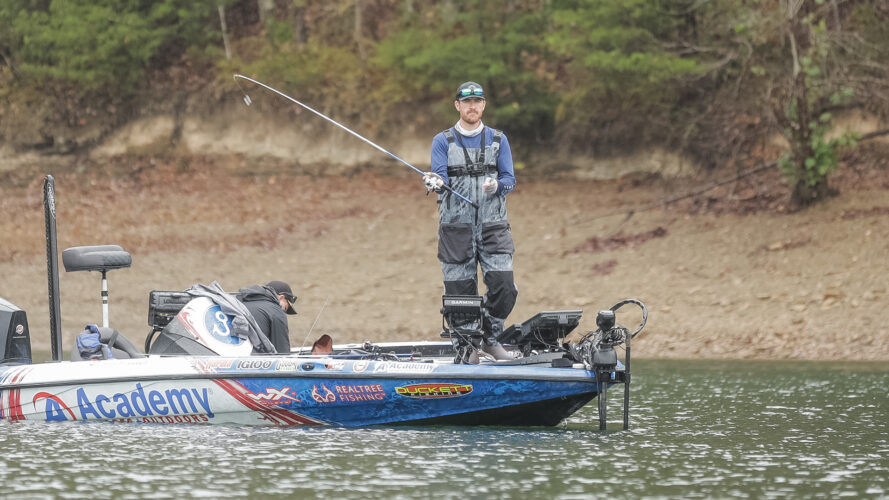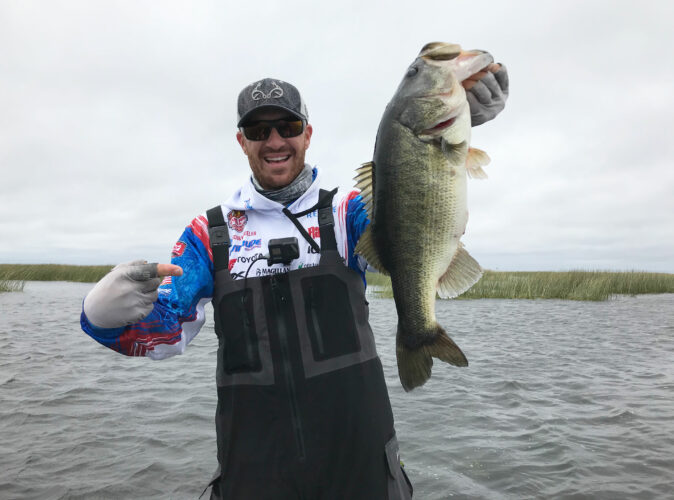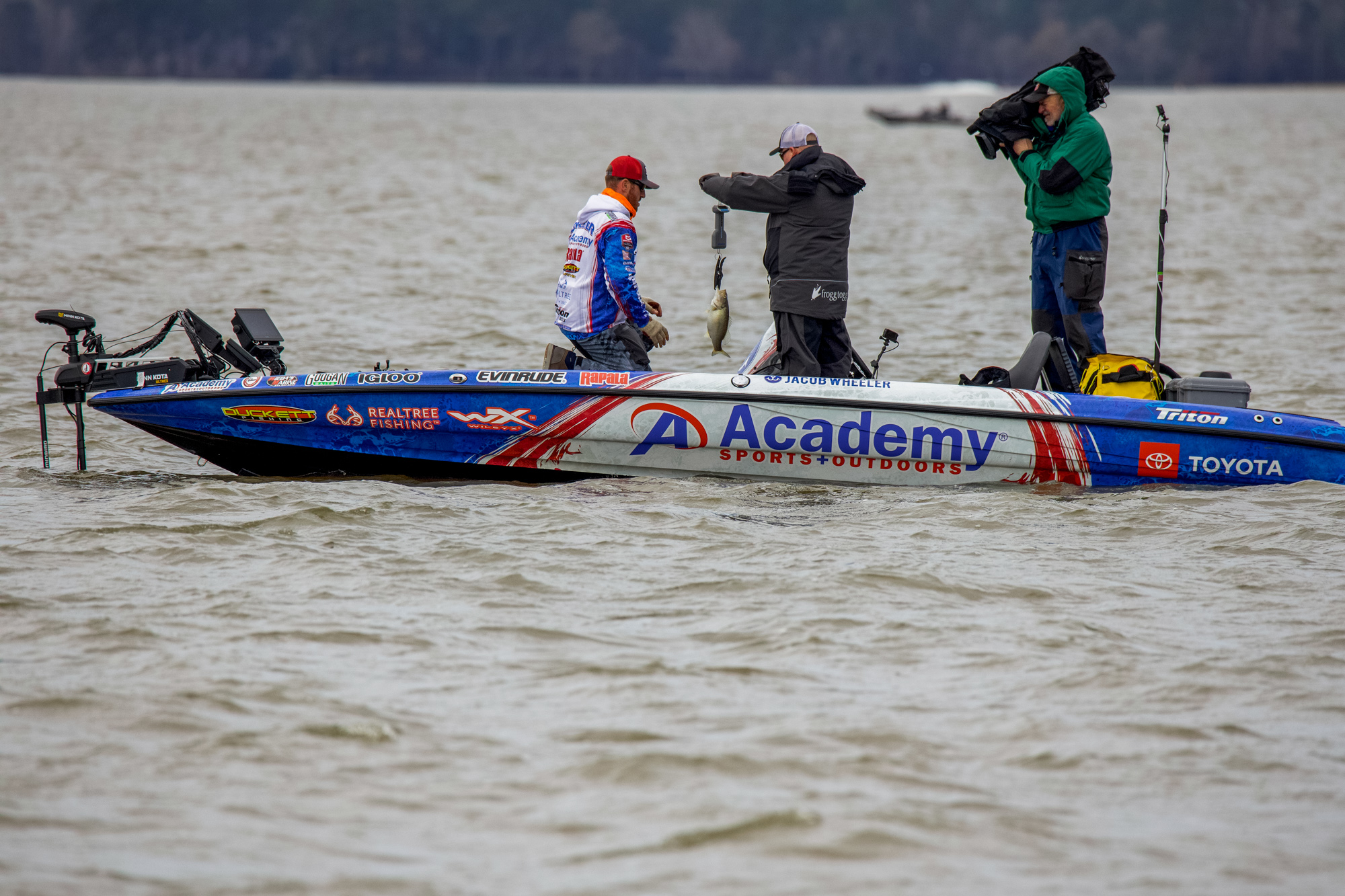Wheeler’s Winter Wisdom: Smaller Swimbaits for Bigger Bites

Winter is no time to rest for Mercury pro Jacob Wheeler.
The Indiana native migrated to eastern Tennessee to take advantage of the region’s varied bass fishing opportunities, and he takes no season off to rest his casting arm.
Nevertheless, he does slow down a bit to suit the season. But that’s only because “slow” is how the bass want it.
“Day in and day out, fishing a finesse swimbait is my favorite technique in (cold) water conditions,” Wheeler admits. “Whether I’m fishing largemouth on Chickamauga or for big smallmouth or spotted bass anywhere I go, the forage is mainly threadfin shad or smaller gizzard shad this time of year. We usually hear that bigger baits catch bigger fish, and that’s normally true. But, in winter, little baits catch as many big fish — and get a lot more bites, too.”
His choice in the chill is the 3-inch Storm Largo Shad.
“A 4-inch model can be a finesse swimbait in summer, especially when you’re fishing offshore,” Wheeler says. “But for winter and cooler temperatures, the 3-inch (Largo Shad) is my finesse swimbait.”
Jighead choice is critical, and Wheeler opts for two designs for “finessy” swimbaiting. For shallow water, he uses a 1/4-ounce VMC Hybrid Swimbait Jig. New to the market this year, the ballhead jig features a wider gap high-carbon hook with a “hybrid” bend for added strength, a 60-degree jig eye, 3D holographic eyes, and a large diameter spring keeper to hold the plastic.
“It’s the best swimbait head out there for what I’m doing,” Wheeler says. “If I’m fishing 10 feet or shallower on a grass fishery or waters where a lipless crankbait prevails this time of year, like on Chickamauga, it’s perfect.”
To work deeper water, particularly on clear highland reservoirs, he switches to a flat-sided aspirin-shaped jighead.
“I’ll change head designs when fishing lakes like Cherokee, Percy Priest or even a Lake Lanier,” he says. “I throw a 3/8-ounce or even 1/2-ounce VMC (Neon) Moon Eye Jig to work 20, 30, 40 or even 50 feet — the same swimbait but a different jighead. Lately, I’ve been catching a lot of fish in that 35- to 45-foot depth range, but 25 to 35 feet is the main depth range to work on a lot of these clear, highland reservoirs.

All About the Bait
But depth in itself isn’t magical. Whether he’s fishing shallow, turbid water or gin-clear depths, Wheeler hunts first for signs of bait presence.
“Bass will be around the bait,” he emphasizes. “The reason the pattern changes so much from a highland reservoir to a Tennessee River lake is the bait is holding at different depths.
Threadfin shad are the main draw. The prior year’s hatch comprises the most abundant forage numbers, which is why bass home in on the smaller shad.
“The fish are still keying on that small bait, the threadfin and smaller gizzard shad, too,” Wheeler says. “It’s that ‘finesse swimbait’ size of bait! If you’re going after a single giant bass, you might throw a big swimbait. I’ve caught enough 7- and 8-pound bass with big gizzard shad coming out of their mouths to know that an opportunistic bass will still eat one. But the majority of the fish target the smaller profile shad.”
Location, Location
On deep, clear reservoirs, Wheeler usually finds bait concentrations in main river channels and adjacent areas or deepwater drains. He usually finds fish stationed in areas with access to water in 30- and 40-foot depths.
“Sharp edges near a concentration of bait is what I look for first — points going into a creek arm, an area where a creek channel runs into a bluff, a channel turn,” Wheeler says. “The majority of the bait tends to congregate there. If bait isn’t there, I venture to some of the pockets and creek arms. The bass this time of year are just following food. They don’t tend to move a heck of a lot because conditions in those deep areas tend to be more stable. But it can change day-to-day.”
Bottom content factors into the formula as well. On some lakes, rock on a point is the best attractor. On others it might be a timber line or edge.
“But the big thing is that bait has to be in the area,” Wheeler reiterates.
Wheeler presents his swimbait to deep bass using the aforementioned 3/8- to 1/2-ounce VMC Moon Eye Jig on a 7-0 medium-power spinning rod with a light tip. Sufix NanoBraid in 8-pound test serves as his main line. He adds a 6- to 7-foot leader of 8-pound Sufix Advance Fluorocarbon for deep water, switching to 10- to 12-pound fluorocarbon when fishing shallow rock or cover-strewn waters.
“I try to get a good 60 or 70 feet off the fish, let the bait go to the bottom and really slow down that swimbait retrieve,” he says. “This time of year, you often find mud on the bellies of the fish, so you really need to slow down. Slow and close to the bottom is the best presentation to catch these bass. I usually wind slowly about a third of the way back, then open my bail and let the bait fall back down. Keep it real slow. As long as that tail is kicking, you’re good.”
Shad colors are his logical choice.
“I use a gizzard shad, a pro blue, and other shad-related colors,” he says. “When the water is stained, I’ll go to a traditional white pearl color.”

Shallow Finesse
Over the years, Wheeler has found the finesse swimbait a superior replacement for a jerkbait and lipless crankbait in many situations.
“In the backs of pockets and creek arms, it gets a few more bites, even when the water is a little stained,” he says. “The fish get keyed in on that bait.”
His shallow water approach is “more bank and grass-line related,” he says, noting that fish often push into the backs of pockets to depths as little as 2 feet. Still, deeper water is almost always close by, though “deep” may be only 8 to 12 feet. Ditches, drains and secondary points also come into play.
Additional colors for stained, shallow water are Black Shad and Sexy Shad. Sometimes, Wheeler adds a highlight of chartreuse.
“When I find them, it’s like throwing a lipless crankbait,” he says. “Just cast and wind. Let it drop back to the bottom a time or two during the cast. You don’t have to wait but a second or two when it’s only 2 or 3 feet deep.”
Wheeler advises to use your eyes and electronics to see signs of bait activity.
“Keep your eyes open,” he advises. “Use the small hints that nature gives you to make better decisions.”